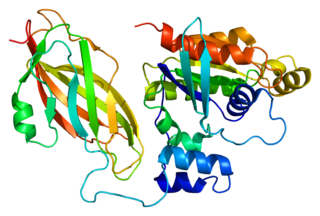Neutrophil cytosol factor 2 is a protein that in humans is encoded by the NCF2 gene.
Neutrophil cytosol factor 2 is a protein that in humans is encoded by the NCF2 gene.
This gene encodes neutrophil cytosolic factor 2, the 67-kilodalton cytosolic subunit of the multi-protein complex known as NADPH oxidase found in neutrophils. This oxidase produces a burst of superoxide which is delivered to the lumen of the neutrophil phagosome. Mutations in this gene, as well as in other NADPH oxidase subunits, can result in chronic granulomatous disease. [5]

Chronic granulomatous disease (CGD), also known as Bridges–Good syndrome, chronic granulomatous disorder, and Quie syndrome, is a diverse group of hereditary diseases in which certain cells of the immune system have difficulty forming the reactive oxygen compounds used to kill certain ingested pathogens. This leads to the formation of granulomas in many organs. CGD affects about 1 in 200,000 people in the United States, with about 20 new cases diagnosed each year.

Myeloperoxidase deficiency is a disorder featuring lack in either the quantity or the function of myeloperoxidase–an iron-containing protein expressed primarily in neutrophil granules. There are two types of myeloperoxidase deficiency: primary/inherited and secondary/acquired. Lack of functional myeloperoxidase leads to less efficient killing of intracellular pathogens, particularly Candida albicans, as well as less efficient production and release of neutrophil extracellular traps (NETs) from the neutrophils to trap and kill extracellular pathogens. Despite these characteristics, more than 95% of individuals with myeloperoxidase deficiency experience no symptoms in their lifetime. For those who do experience symptoms, the most common symptom is frequent infections by Candida albicans. Individuals with myeloperoxidase deficiency also experience higher rates of chronic inflammatory conditions. Myeloperoxidase deficiency is diagnosed using flow cytometry or cytochemical stains. There is no treatment for myeloperoxidase deficiency itself. Rather, in the rare cases that individuals experience symptoms, these infections should be treated.
Respiratory burst is the rapid release of the reactive oxygen species (ROS), superoxide anion and hydrogen peroxide, from different cell types.
NADPH oxidase is a membrane-bound enzyme complex that faces the extracellular space. It can be found in the plasma membrane as well as in the membranes of phagosomes used by neutrophil white blood cells to engulf microorganisms. Human isoforms of the catalytic component of the complex include NOX1, NOX2, NOX3, NOX4, NOX5, DUOX1, and DUOX2.

NADPH oxidase 2 (Nox2), also known as cytochrome b(558) subunit beta or Cytochrome b-245 heavy chain, is a protein that in humans is encoded by the NOX2 gene. The protein is a superoxide generating enzyme which forms reactive oxygen species (ROS).
Anthony Walter Segal FRS FMedSci is a British physician/scientist.

The PX domain is a phosphoinositide-binding structural domain involved in targeting of proteins to cell membranes.

Neutrophil cytosol factor 1, also known as p47phox, is a protein that in humans is encoded by the NCF1 gene.

NADPH oxidase 1 is an enzyme that in humans is encoded by the NOX1 gene.

Cytochrome b-245 light chain is a protein that in humans is encoded by the CYBA gene involved in superoxide production and phagocytosis.

RHO protein GDP dissociation inhibitor of Rho proteins, regulates GDP/GTP exchange.

Rac2 is a small signaling G protein, and is a member of the Rac subfamily of the family Rho family of GTPases. It is encoded by the gene RAC2.

Neutrophil cytosol factor 4 is a protein that in humans is encoded by the NCF4 gene.

Dual oxidase 2, also known as DUOX2 or ThOX2, is an enzyme that in humans is encoded by the DUOX2 gene. Dual oxidase is an enzyme that was first identified in the mammalian thyroid gland. In humans, two isoforms are found; hDUOX1 and hDUOX2. The protein location is not exclusive to thyroid tissue; hDUOX1 is prominent in airway epithelial cells and hDUOX2 in the salivary glands and gastrointestinal tract.

NADPH oxidase organizer 1 is an enzyme that in humans is encoded by the NOXO1 gene.

NADPH oxidase 3 is an enzyme that in humans is encoded by the NOX3 gene.

NADPH oxidase activator 1 is an enzyme that in humans is encoded by the NOXA1 gene.
p22phox Protein, also known as the human neutrophil cytochrome b light chain (CYBA), is an essential component of the membrane-associated enzyme phagocyte NADPH-oxidase This enzyme uses NADH or NADPH as the electron donor for the one electron reduction of oxygen to produce superoxide anion, a reactive oxygen species (ROS), and a functionally important step for the antimicrobial activity of phagocytic cells. p22phox is also expressed in many other human cells such as endothelial and vascular smooth muscle cells, including those within the coronary arteries. Specific polymorphisms of the CYBA gene have been identified that are associated with a decreased risk of coronary artery disease (CAD).

John I. Gallin is an American medical researcher who has contributed to the understanding of innate immunity but especially chronic granulomatous disease, a phagocyte disorder. Gallin was appointed director of the NIH Clinical Center on May 1, 1994, and served until January 8, 2017. He serves as the chief scientific officer for the Clinical Center and associate director for Clinical Research at the National Institutes of Health.
Edgar Pick is an Israeli immunologist who is Professor Emeritus of Immunology in the Department of Clinical Microbiology and Immunology at the Sackler Faculty of Medicine at Tel Aviv University, Israel.